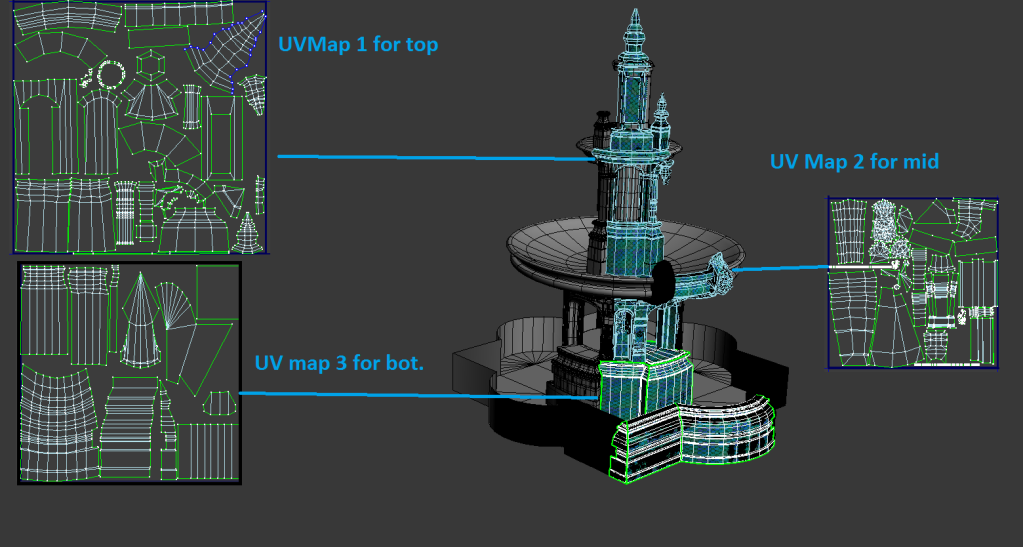The BRAWL² Tournament Challenge has been announced!
It starts May 12, and ends Oct 17. Let's see what you got!
https://polycount.com/discussion/237047/the-brawl²-tournament
It starts May 12, and ends Oct 17. Let's see what you got!
https://polycount.com/discussion/237047/the-brawl²-tournament
Determining how many UV maps an object should have and texture resolution size?
Are there any general rules of thumb for how many UV maps an object should have, or how large the maps should be?
For Instance I am in the process of creating the LP of this p90. Should the whole gun be unwrapped such that it only takes up one UV space, and thus one map?

In an Eat3D DVD entitled "the fountain" the author creates 3 separate UV maps for the whole fountain piece. He does one for the base, middle, and top of the object. I am unclear on what circumstances warrant this, obviously it would have to be a pretty important set piece to warrant 3 UV maps, but other than that the details are unclear.
e.g.

Also not sure if the phrase im using "UV maps" is correct. Also how I know this is dependent on many variables, but are there any general rules of thumb for what the texture budgets for objects should be. e.g. A medium prop might get 512x512, a big prop might get 2048x2048 etc.
For Instance I am in the process of creating the LP of this p90. Should the whole gun be unwrapped such that it only takes up one UV space, and thus one map?

In an Eat3D DVD entitled "the fountain" the author creates 3 separate UV maps for the whole fountain piece. He does one for the base, middle, and top of the object. I am unclear on what circumstances warrant this, obviously it would have to be a pretty important set piece to warrant 3 UV maps, but other than that the details are unclear.
e.g.

Also not sure if the phrase im using "UV maps" is correct. Also how I know this is dependent on many variables, but are there any general rules of thumb for what the texture budgets for objects should be. e.g. A medium prop might get 512x512, a big prop might get 2048x2048 etc.
Replies
B. It isn't faster load more, smaller textures on any modern hardware, AFAIK.
C. Its going to be faster to use one shader, ie: one draw call. So one texture is generally best.
The only time you really want multiple UV maps is if you're only going to see a portion of the mesh in some areas. Say, your magazine and sight is swappable, you would give these each unique uvs, as you would swap them out in memory with different accessories. The fountain thing doesn't really make much sense, there isn't any benefit to splitting that up, other than the fact that you're using 3x516 instead of 1x1024 or something, which is less memory, however less detail too of course.
For the asset in question, 1 2048x2048 for a detail first person weapon Is pretty common(would be sized down for consoles however).
Mirror what you can without being obvious. I always try to make sure that the "tops" and "ends" of areas, especially those you would see in FPV are not mirrored.
Give more uv space to areas that are up close in FPV and will be seen the most. Give even more space to areas like scopes/iron sights that will zoomed in on
Everything else should have an even amount of space
In some cases, for areas that will very rarely/never been seen up close or be occluded all of the time, less uv space can be ok to use.
Beneficial?
Edit: here we go http://www.polycount.com/forum/showthread.php?t=83088
Now, consider that every time you split up your mesh you're also going to create seams, this can cause trouble when you're trying to bake a complex high with a lot of material types down to a seamless low, using a bunch of materials just isn't a good idea most of the time.
Now in addition, the example of concrete/metal, you can simply use very dark values in your spec for the concrete to have little/no specular reflection, you dont need to set up an entirely new shader for this.
Specialized shader effects like water, or anything with alpha, generally should be split off into a separate texture/shader, however.
WHA?? One shader/material for an entire game? I think not. Concrete is very much different from metal, which is very much different from wood, paper, glass etc etc. Unless your doing some sort of toonshaded game where there's no specular/reflection and only a diffuse and normal, then you absolutely need more then one shader/material.